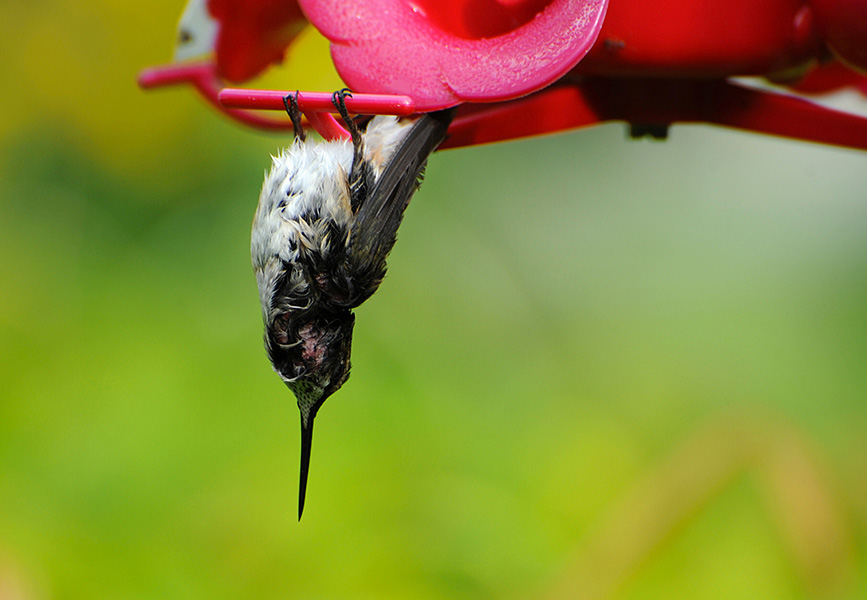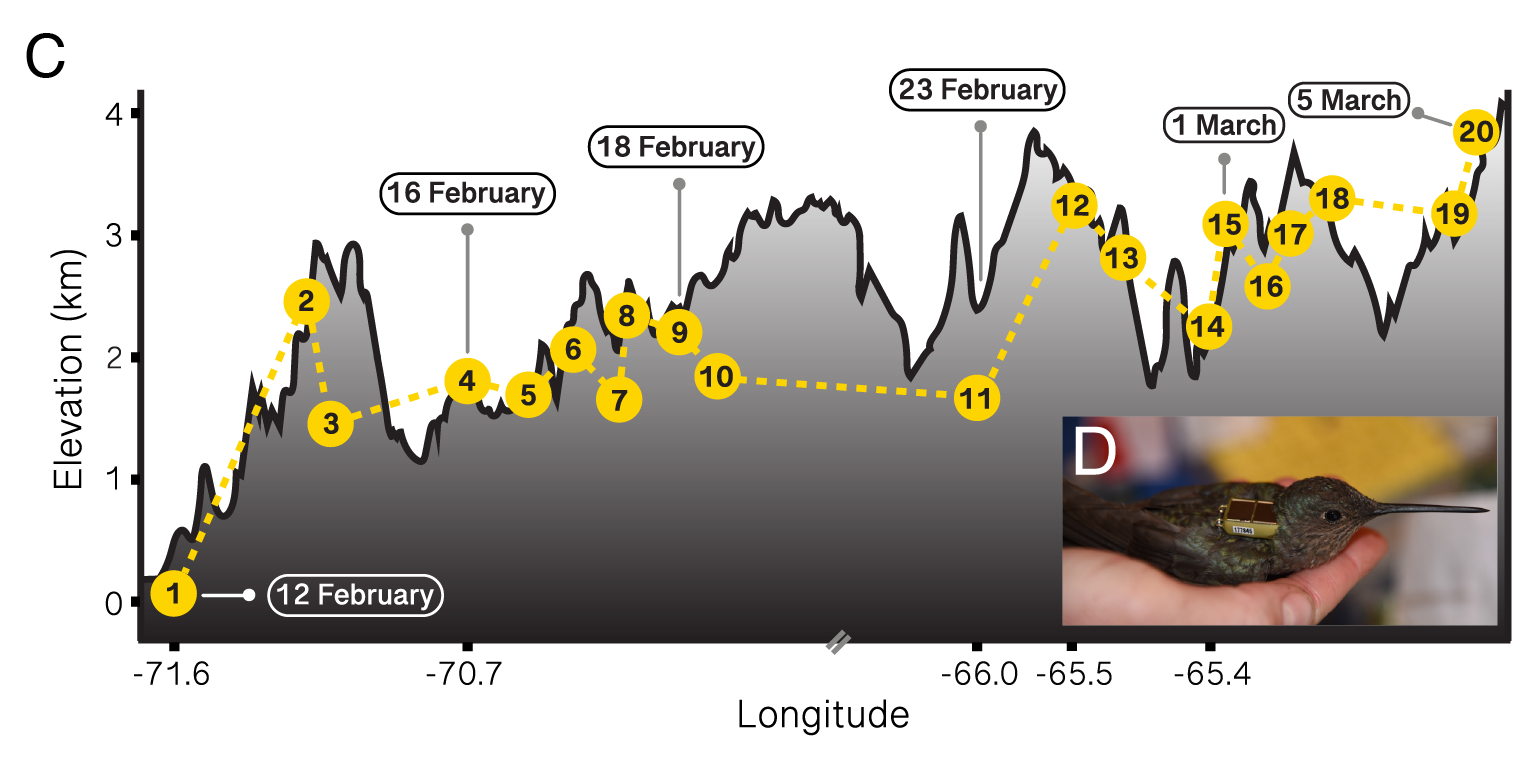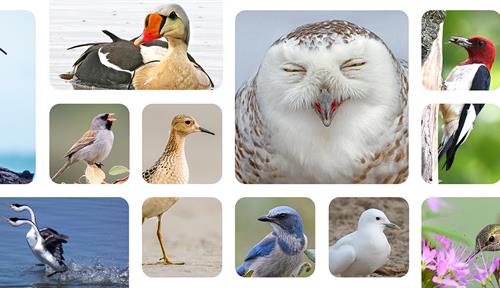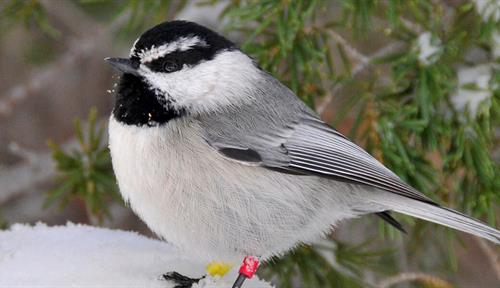Hummingbirds thrive on an extreme lifestyle. Here’s how.
Soldiering through nightly suspended animation, a (nearly) all-sugar diet, backwards flight and long migrations, the birds’ tiny physiques prove mighty
Support sound science and smart stories
Help us make scientific knowledge accessible to all
Donate today
Everyone loves to watch hummingbirds — tiny, brightly colored blurs that dart about, hovering at flowers and pugnaciously defending their ownership of a feeder.
But to the scientists who study them, hummingbirds offer much more than an entertaining spectacle. Their small size and blazing metabolism mean they live life on a knife-edge, sometimes needing to shut down their bodies almost completely just to conserve enough energy to survive the night — or to migrate thousands of miles, at times across open ocean.
Their nectar-rich diet leads to blood-sugar levels that would put a person in a coma. And their zipping, zooming flight sometimes generates g-forces high enough to make a fighter pilot black out. The more researchers look, the more surprises lurk within those tiny bodies, the smallest in the avian world.
“They’re the only bird in the world that can fly upside down and backwards,” says Holly Ernest, a conservation ecologist with the University of Wyoming. “They drink pure sugar and don’t die of diabetes.”
Ernest is one of a small number of researchers studying how hummingbirds cope with the extreme demands of their lifestyles. Here’s some of what scientists have learned about the unique adaptations of hummingbirds.
Put in the work
For years, most researchers had assumed that hummingbirds spent only about 30 percent of their day engaged in the energy-intensive business of flitting from flower to flower and guzzling nectar, while resting most of the other time. But when physiological ecologist Anusha Shankar looked closely, she found they’re often working a lot harder than that.
Shankar, now of the Tata Institute of Fundamental Research in Hyderabad, India, tried to figure out how broad-billed hummingbirds in Southern Arizona spend their days. Using a mix of experimental methods, she measured the birds’ metabolic rate during various activities and estimated their total daily energy expenditure. Adding in previous published data, Shankar was able to calculate the per-minute energy cost of perching, flying and hovering — basically a bird’s three options for spending time.
She then inferred how much time the birds must have spent feeding versus perching over the course of a day.
“We ended up finding that it’s super variable,” Shankar says. During the early part of the summer when flowers are abundant, birds could meet their daily energy needs with as little as a few hours of feeding, spending as much as 70 percent of the day just perching, she found. But when flowers became scarcer after the arrival of the summer monsoon rains, birds at one site perched just 20 percent of the time and used the rest of the day for feeding.
“That’s 13 hours a day!” Shankar says. “There’s no way I can spend 13 hours a day running. I don’t know how they do it.”
Seriously chill
Hummingbirds have a trick to help them eke out their energy reserves: When a bird is in danger of running out of energy, it may go torpid at night, dropping its body temperature nearly to that of the surrounding air — sometimes just a few degrees above freezing. While in torpor, the bird appears almost comatose, unable to respond quickly to stimuli, and breathing only intermittently. The strategy can save up to 95 percent of hourly metabolic costs during cold nights, Shankar has calculated. That can be essential after days when a bird has fed less than usual, such as after a thunderstorm. It also helps birds save energy to pack on fat before migration.
Shankar is now studying which parts of their physiology hummingbirds prioritize during torpor, by looking to see which gene products they can’t do without. “If you’re a hummingbird functioning at 10 percent of your normal metabolism, what is that 10 percent that’s keeping you alive?” she asks.

Many hummingbirds, such as this one, can enter a state of torpor, a form of hibernation in which they let their body temperature drop to near that of the air. Torpor saves the birds energy — especially important at night — but arousing from it can take many minutes and leave the birds vulnerable.
CREDIT: KELLYPLZ / POND5
One set of genes that the birds seem to leave untouched are those responsible for their internal clock. “It’s important for them to do things at the right time when they’re in torpor,” Shankar says. To be ready to meet the day, for example, the birds begin to rouse from their torpor about an hour before sunrise, well before visible light cues.
Deal with the sugar
To fuel their sky-high metabolic rate, hummingbirds suck down about 80 percent of their body weight in nectar each day. That’s the equivalent of a 150-pound person drinking nearly a hundred 20-ounce Cokes daily — and nectar is often much sweeter than a soda.
The human gut is incapable of absorbing sugar that fast, which is one reason why consuming too much soda or Halloween candy upsets the stomach, says Ken Welch, a comparative physiologist at the University of Toronto at Scarborough. Hummingbirds cope with the onslaught by having leaky guts so that sugars can enter the bloodstream between gut cells instead of only through them. This gets sugar out of the gut quickly, before it can cause upset. That rapid transport, and probably other adaptations as well, allows hummingbirds to reach blood sugar levels as much as six times higher than those seen in people, Welch says.
That much sugar in the blood leads to serious physiological problems in people. It causes more sugar molecules to glom onto body proteins, a process known as glycation; in the long run, excess glycation causes many of the complications of diabetes, such as nerve damage. It’s still unclear how hummingbirds avoid the problems of glycation, Welch says, but clues are beginning to emerge. One study, for example, found that bird proteins contain fewer of the amino acids most prone to glycation than mammal proteins, and those that remain are often tucked deep within the protein where they’re less exposed to circulating sugars.
Other, as yet unknown strategies to cope with high blood sugar may one day yield practical benefits for managing diabetes in people. “There could be a gold mine in the genome of the hummingbird,” says Welch.
Do a metabolic flip
By the end of its nightly fast, a hummingbird has nearly depleted its sugar stores — which poses an opposite metabolic challenge. “How does it wake up and fly?” Welch asks. “There’s nothing but fat available to burn.”
Hummingbirds have evolved to be remarkably nimble at switching their metabolism from sugar-burning to fat-burning, he has found. “This requires an enormous shift in the biochemical pathways that are involved,” Welch says — and it happens in mere minutes, far more quickly than other organisms can manage. “If we could have that kind of control over our fuel use, we’d love that.”
Save water — or not
Sugar isn’t the only challenge posed by a nectar-rich diet. After all, nectar is mostly water — and birds that drink in so much liquid must get rid of most of it, without losing electrolytes. As a result, hummingbird kidneys are highly adapted to recapture electrolytes before they are excreted. “They pee almost distilled water,” says Carlos Martinez del Rio, an ecophysiologist now retired from the University of Wyoming.
But that brings a further problem: If a hummingbird kept producing dilute urine overnight, it would die of dehydration before morning. To avoid that, hummingbirds shut down their kidneys every night. “They go into what, in a human, would be considered acute renal failure,” says Martinez del Rio. “Hummingbirds have to do this, or they would piss themselves to death.”
Fly high — gradually
The metabolic demands on a hummingbird are tough enough at sea level. But many species live at high elevations, where thin air contains less oxygen and offers less resistance to push against when hovering. Consider the giant hummingbird, the world’s largest, which can live in the Andes Mountains at elevations over 14,000 feet — higher than many helicopters can fly. To cope with these conditions, the birds have evolved more hemoglobin-rich blood, says Jessie Williamson, an ornithologist at Cornell University.
But some of the birds face an even steeper challenge, as Williamson found. Giant hummingbirds are large enough that researchers can attach satellite tracking tags, as well as smaller geolocators. So Williamson and her colleagues decided to fit the birds with trackers. After thousands of hours spent trying to capture birds with netting, the researchers managed to attach trackers to 57 birds using custom-made harnesses of elastic jewelry cord.

A giant hummingbird (such as the one pictured in inset) wore a GPS tracker during its migration from the Chilean coast to the heights of the Andes. Like human climbers gradually adapting to altitude, the bird ascended in a series of shorter climbs followed by pauses to adjust to the conditions at higher elevation. The whole journey took nearly three weeks.
CREDIT: J.L. WILLIAMSON ET AL / PNAS 2024
Though they recovered tracking data from only eight birds, even that tiny sample had a big surprise: Some of the birds lived in the high Andes year-round, while others — which turned out to be a separate, hitherto unrecognized species — migrate to the Andes annually from breeding grounds along the coast of Chile. That means they face not only the obvious challenges of a long migration — a round trip of roughly 5,000 miles — but also the need to adapt to thinner air as they travel.
Their secret? Do it gradually. “It looks a lot like how human mountaineers summit something like Mount Everest, with bursts of climbing and pauses to acclimatize,” Williamson says. “The journey takes months.”
As tracking technology becomes lighter and cheaper, researchers like Williamson hope to follow smaller hummingbird species as well. That, together with other progress in research technology, may offer plenty of new surprises about the biology of these tiny, amazing birds.
10.1146/knowable-092524-1
TAKE A DEEPER DIVE | Explore Related Scholarly Articles






